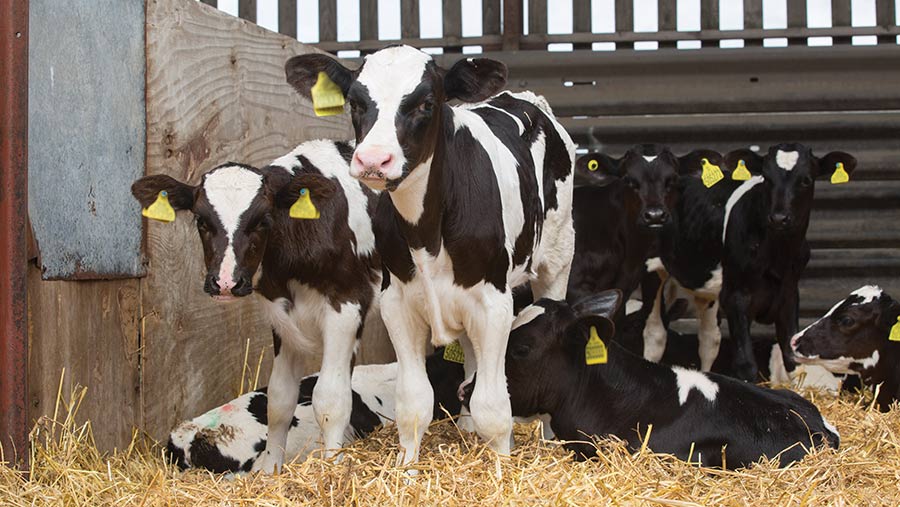How genetics and data sharing can aid calf management
 © Tim Scrivener
© Tim Scrivener A high percentage of dairy and suckler farmers report that calves are born dead on arrival. In an exclusive Farmers Weekly survey, 21% of dairy farmers and 29% of suckler farmers said this was one of the leading causes of mortality among calves.
Farmers Weekly invited farmers, vets and industry partners to a roundtable discussion in Shropshire to find out how the industry can improve the sustainability of beef and dairy calf management by using the right genetics and sharing data.
See also: What is holding back improvements in youngstock management?
Starting with the right genetics
“Day one is not the day that calves are born,” said Mark Smith, EMEA beef director at Genus ABS.
“A youngstock programme starts with a plan. It is about having the right strategy, for producing the right calves, for the right end game.”
He said dairy farmers should start by working out their replacement rate, then use the most appropriate genetics to meet the requirements of their milk contract.
“Farmers should be looking to reduce their carbon footprint by producing the right number of heifers for their farm and using more beef semen on the remaining cows within the herd.”
Similarly, he said beef genetics should be chosen with the end market in mind. He believes farmers should select fast-growing bulls that are feed efficient, with good carcass qualities.
“You can select animals that have a small birthweight and are heavier at slaughter. We don’t need to make that calf any bigger,” he stressed.
He added: “The national suckler herd is declining at a rapid rate. We are producing less beef than we ever have, and we are only 75% self-sufficient in beef.
“We must, therefore, ensure we are producing a beef calf that somebody wants.”
Spring calver Catherine Pickford believes better supply chain integration and education are imperative to ensure beef calves born from spring-calving cows reach their full market value.
These calves are often deemed poorer quality because they are born to smaller cows.
“Beef calves from a system like mine have a place, but that needs to be communicated with beef buyers,” she added.

Delegates at the roundtable © Richard Stanton
Improving efficiency through genetics
Using better genetics will enable farmers to make faster progress in improving feed efficiency and lowering methane, said Mark.
This is something Catherine is already using to her advantage. She is culling the bottom 10% of her herd based on their performance efficiency.
“We can produce just as much milk with the cows that are left, which is improving our carbon footprint,” she explained.
Currently, average cow mature weight in her herd is 513kg. Cows are weighed four times annually and the target is for a 500kg cow to produce 500kg of milk solids from 500kg of concentrate.
In 2021, cows produced 472kg of milk solids from 600kg of concentrate.
Data capture and sharing
Herdwatch’s UK manager, Mel Griffith, urged farmers to record sires on animal passports.
“Not doing it is a way to lose money, because 90% of the time you will get a better price [if you do], and that information is valuable and can be shared up and down the chain.”
Mel believes better use of data and recording is vital to drive improvements in animal performance.
In Ireland, commercial data and cross-sector co-operation have driven national cattle estimated breeding values (EBVs) since the launch of the Irish Cattle Breeding Federation database in 2000.
Mark said this information, alongside vaccination records, was readily displayed at Irish markets and was something that should be emulated in the UK to add value to animals.
It is hoped the Livestock Information Service, a digital traceability system that will replace the British Cattle Movement Service (BCMS), will facilitate the use of more data when it launches in late 2024.
TB restricting progress
However, delegates at the roundtable agreed TB was a huge issue that was hampering progress, because when a farm is shut down, the calf value is so low that these animals are unprofitable.
Furthermore, there are not enough outlets for such calves.
Currently, both Catherine and Shropshire dairy farmer Ruth Ashley are under TB restrictions.
The change in Ruth’s herd’s TB status – together with payment of just £28 a head for some calves at market – forced her to switch to finishing beef cattle.
As well as putting pressure on stocking rates, the restrictions imposed by TB are hindering their ability to manage replacement rates. It can also leave farm businesses haemorrhaging cash, they explained.
TB isolation units provide an outlet for calves, or store cattle, from TB-restricted holdings lacking facilities for rearing. However, gaining approval for these units can be notoriously difficult.
Sarah Tomlinson, a Kingshay veterinary consultant, was approached for a comment following the discussion. She told Farmers Weekly it must be made easier for farmers in all regions of the UK to get isolation units approved through better government guidance.
In addition, more approved finishing units for clear-tested cattle from TB-restricted holdings are also needed.
“Until we can sort out TB, all the sustainability stuff goes out of the window because farmers haven’t got the resource – mentally or financially – to deal with anything else,” she said.
“The industry needs to up its game and consider how integrated supply chains can work better.”
Solutions
- Make use of genetic valuations through your breeding company, or AHDB Dairy, to ensure you are using the right genetics to meet your buyer’s requirements
- Where possible, work with your beef calf buyer to get feedback and choose suitable bulls
- More outlets for TB and better guidance are required for farmers applying for isolation units
- Farmers need to record key data, and information should be shared across the supply chain
- Markets need to make better use of data to add value to stock.
Roundtable delegates
- Ruth Ashley, dairy farmer, Shropshire
- Catherine Pickford, dairy farmer, Somerset
- Sabrina Jordan, product manager, Virbac UK
- Mel Griffith, UK manager at Herdwatch
- Mark Smith, EMEA beef director, Genus ABS
- Ian Watson, technical manager, Volac
- Jessica Cooke, research and development manager, Volac
- Katie Fitzgerald, Bishopton Vets
- Jenny Gibbons, animal health and welfare scientist, AHDB
About the Calf Sustainability project
Livestock farmers in the UK are facing increasing pressures for a number of reasons. This project aims to open up the conversation around best practice to help producers ensure a sustainable future for all their businesses.
Farmers Weekly worked with seven partners to help make this possible. Farmers Weekly had full editorial control of this report.
